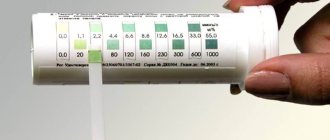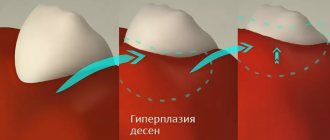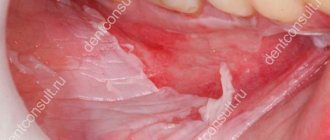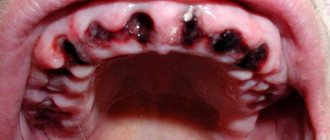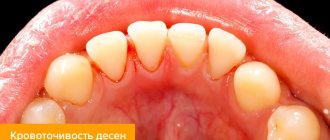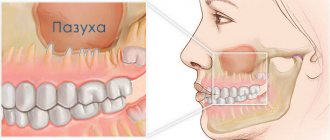Why does blood appear on teeth and how to deal with the problem
Bleeding gums are an alarming symptom that does not occur on its own, but is a sign of poor oral health. The problem cannot be left to chance. To find out the reasons for its appearance, you need to consult a dentist: if your gums are bleeding, this may indicate the development of a serious oral disease or an infection. In addition, the lack of timely treatment contributes to the appearance of bad breath, which will reduce the quality of life and lead to the development of complexes.
Why do my gums bleed?
They are a mucous membrane that covers the alveolar part of the lower jaw and the alveolar process of the upper. This shell wraps around the teeth in the area of their neck, protecting dental tissues from various damages, and the teeth themselves from falling out.
Bleeding of this mucous membrane, as a rule, is a symptom of some disease of the oral cavity or body. Under the influence of various factors, the tissues are weakened, and, as a result, the gums bleed. These are the reasons why this problem appears. They will be discussed in more detail below.
Causal factors for bleeding
Normally, the gums are pink, smooth, dense, and fit well to the teeth. Any changes, including the appearance of bleeding, should be cause for concern. Various reasons can provoke the occurrence of an undesirable symptom.
Oral diseases
Often the problem begins as a result of bacterial activity. Under favorable conditions, namely insufficient oral hygiene, they actively reproduce. Because of this, a soft plaque forms on the teeth, which calcifies over time. This is how tartar appears. These are already solid deposits that provoke the development of an inflammatory process, which threatens the appearance of the following diseases:
- Gingivitis. When the disease occurs, the marginal part of the gum and interdental papillae become inflamed. In addition to bleeding, redness and swelling are formed in those areas where the mucous membrane comes into contact with dental plaque.
- Periodontitis. The disease manifests itself as a result of untreated gingivitis. In this case, the pathological process moves to periodontal tissues - those that hold the tooth in the socket.
The appearance of gingivitis and periodontitis is possible not only in an adult, but also in a child. According to statistics, tartar occurs in 2/3 of all high school students, and 1/4 of school-age children experience gingivitis.
Other diseases
The cause of bleeding may be vitamin deficiency. It is difficult to determine which vitamins are lacking when it occurs, because an imbalanced diet in general has a bad effect on oral health. But it is worth introducing foods containing iron, vitamin C and potassium into your diet. If you have an unpleasant symptom, you must also exclude the following diseases and pathologies:
- disruption of the gastrointestinal tract and endocrine system;
- blood diseases;
- diabetes;
- AIDS;
- disruption of metabolic processes in the body;
- fragility of blood vessels;
- infectious diseases of the throat and nose;
- allergic reaction to medications, materials used in dentistry, toothpaste.
Bleeding gums are common in pregnant women and teenagers. This is explained by hormonal changes in the body. Expectant mothers often note that their gums hurt and swell. This condition is short-term and goes away on its own.
Common reasons
As already mentioned, blood in the mouth can occur due to poor oral hygiene. Incorrect brushing technique (strong, intense pressure) can lead to injury to the gums. Thus, using a hard toothbrush is a constant traumatic factor. Wisdom teeth are often difficult to clean. Due to problems with access, the brush hurts the gums. Bleeding may also occur for the following reasons:
- wearing braces or dentures;
- malocclusion;
- incorrect dental treatment of teeth or gums;
- smoking - bleeding occurs due to toxins that irritate saliva and weakened immunity in smokers;
- burn and injury to the mucous membrane with a sharp object;
- chipping of an old filling.
Taking certain medications can sometimes cause a decrease in the rate of saliva production. Since it resists bacteria, this can provoke a sharp development of pathogenic microflora.
First aid for venous bleeding
With venous bleeding, a stream of blood comes to the surface at high speed so that it does not allow a blood clot to form and stop the bleeding.
As a result, a person may lose a large amount of blood.
Algorithm for providing assistance:
- Raise the injured limb upward;
- Cover the wound with a bandage or clean cloth folded several times;
- Cover the wound tightly with a bandage.
In case of severe venous bleeding, a tourniquet is applied and then cold is applied to the wound. Next, go to the hospital for help.
Symptoms accompanying gum disease
Pathologies that cause blood from the mouth may be accompanied by a number of other unpleasant symptoms:
- swelling of the gums;
- pain when pressing or eating solid foods (sometimes the pain is quite severe);
- itching and discomfort in the gum tissue;
- bad breath;
- tooth mobility (with advanced dental diseases).
Even if nothing bothers you throughout the day, and blood appears only when brushing your teeth, this may indicate a problem.
Symptoms of bleeding
The main symptom is the appearance of blood from the nasal sinuses, its flow outward and inward (through the nasopharynx). Bleeding may also be accompanied by the following symptoms:
- increased heart rate;
- decrease in blood pressure;
- nausea;
- general weakness;
- headache;
- dizziness;
- feeling of fullness in the ears;
- paleness of the skin of the face and hands.
Bleeding can be either light or heavy. Depending on the volume of blood lost, there are 3 degrees of severity:
- light – up to 500 ml;
- average – 500-1400 ml;
- heavy – more than 1400 ml.
How to quickly stop bleeding from gums
What to do if you need to quickly stop bleeding from your gums? For this purpose, you can use one of the following methods:
- Rinse your mouth with cold water or mint mouthwash. Decoctions of herbs - chamomile, oak bark, fir, calendula - help reduce the manifestations of unwanted symptoms.
- Apply a cotton swab soaked in chlorhexidine to the bleeding area. You need to press it tightly and wait until the bleeding stops.
- Glue a special protective homeopathic strip. You can buy it at the pharmacy.
No matter how long your gums bleed, you cannot put off a visit to the dentist. The problem will not go away on its own, but will only get worse.
Emergency care for arterial bleeding
Remember that in case of arterial bleeding you cannot hesitate!
Quickly assess the situation and proceed to provide assistance. First of all, pinch the artery with your finger:
If bleeding is in the face area, press your finger on the corner of the lower jaw.
If bleeding is from the head area, then press your finger on the temporal bone in front of the ear.
If bleeding is in the area of the shoulder joint, then press the subclavian artery to the rib.
If bleeding is in the area of the hand, then press the brachial artery to the bone from the side of the shoulder.
If there is bleeding in the thigh area, then you need to press your fist on the frontal bone in the groin area.
Next you need to apply a tourniquet. To temporarily stop arterial bleeding, an Esmarch tourniquet or improvised rubber material is used. Rules for applying a tourniquet:
- Raise, if possible, the victim's arm/leg - this will lead to the outflow of venous blood from the limb;
- Place the tourniquet over the victim’s clothing or a piece of fabric: this is necessary so as not to injure the person’s skin.
- The first 2 turns need to be made the tightest, the crosshair is applied on the back side of the artery. Make sure that the bleeding from the wound has stopped and the skin below the tourniquet has turned pale.
- The victim should be immediately sent to the hospital or call an ambulance.
If you do not achieve complete disappearance of the pulse on the radial artery, then within 10-15 minutes the hand will swell and turn blue. Then the tourniquet can be removed only if the arm is amputated. Record the time of application of the tourniquet. The maximum permissible time in summer is 90 minutes, in winter – 60 minutes, otherwise tissue necrosis occurs.
Every 30-40 minutes, regardless of the time of year, you should remove the tourniquet for 20-30 seconds (until the skin below its application turns pink). This is done so that blood can enter the damaged limb to supply it with oxygen and remove metabolic products.
Then the tourniquet should be applied again below or above its previous location. You can do this for several hours.
How to eliminate constant bleeding gums
To carry out successful treatment, it is important to find out why the gums are bleeding. You should not self-medicate, since the problem requires an integrated approach, which consists in eliminating the cause and restoring the health of the gums. Only a doctor can tell you how to treat a disease that causes bleeding. Different techniques may be needed.
Professional teeth cleaning
If dental plaque provokes complications in the form of bleeding, it is necessary to thoroughly clean your teeth. This does not mean ordinary hygiene procedures at home, but hardware cleaning in a dental office. The doctor uses ultrasound to crush the tartar, the particles of which are washed out with a mixture of water and air. You need to carry out a hygiene procedure twice a year. Unfortunately, not all patients comply with such recommendations.
Air Flow technology is used to remove soft deposits. In this case, finely dispersed soda is supplied along with water. After the procedure is completed, the teeth are polished, which further prevents the accumulation of plaque.
Such actions are sufficient for diagnosed gingivitis. The doctor will also tell you what to do to restore the mucous membrane. This may include rinsing or taking certain medications. Professional teeth cleaning is used if gingivitis has progressed to periodontitis. But this is only the beginning of treatment. Let's talk about ways to eliminate the disease further. If periodontal pockets have formed, you will need powerful ultrasound devices, such as Vector. In this case, the periodontist should deal with oral hygiene.
Rinse with solutions
Antiseptic treatment of the oral cavity can be carried out in the form of rinses based on the following agents:
- "Furacilina";
- "Rotokana";
- "Miramistina";
- "Chlorhexidine";
- alcohol solution "Chlorophyllipt".
Soda-saline solution also helps. You can add a few drops of iodine to it. It is better to use solutions through an irrigator - this increases their effectiveness. In case of bleeding, you need to use special toothpastes, including Parodontax, Lakalut, Colgate Total Pro. The compositions should not have a bleaching effect.
Drug therapy
To eliminate bleeding gums, the doctor may prescribe ointments and gels. They are applied to the problem area after rinsing the mouth. The following drugs are in demand in dental practice:
- "Metrogil Denta" - has antibacterial and anti-inflammatory properties, often prescribed for stomatitis, after tooth extraction;
- “Asepta” is a propolis-based gel that quickly relieves inflammation;
- "Kamistad" is a drug available in two forms (for children and adults);
- "Elugel" is a strong antiseptic that effectively fights pathogenic environments.
For inflammatory processes, the doctor may prescribe medicinal bandages, antibiotics (in some cases), and a course of vitamins.
Gum curettage
For periodontitis with the formation of deep periodontal pockets, the following surgical techniques are used:
- Closed curettage. To carry out the procedure, the doctor uses a special instrument – a curette. With its help, the doctor cleans the roots of the teeth. The tool penetrates to a depth of 3 mm.
- Open curettage. The technique is used when the deposits are deeper. It involves the following actions: peeling of the gums, cleaning and antibacterial treatment, suturing.
The disease can be cured using an integrated approach. Therefore, it is important to follow all doctor’s recommendations even after the procedure.
Types and signs of external bleeding
Methods to stop bleeding largely depend on their location. Each type has its own external manifestations, to which you need to react in time:
- capillary bleeding - occurs due to damage to small vessels as a result of injury or illness. It manifests itself first in the form of blood dew, and then as a slow flow of blood beyond the skin. This condition can be especially dangerous for people with bleeding disorders;
- internal (parenchymal) bleeding is a rather dangerous condition observed as a result of damage to internal organs that have a large blood supply network (spleen, liver, kidneys);
- arterial bleeding is the result of damage to the aorta, femoral and other arteries and manifests itself in the form of a stream of bright scarlet color with pulsation. The danger of such blood loss is its rapid nature, and therefore the timeliness of assistance in fractions of a second plays a vital role in avoiding death caused by damage to the main artery;
- venous bleeding is the slowest. The blood flows out thick, dark burgundy in color, and clots may form. Bleeding from a damaged vein is dangerous due to the detachment of a blood clot, significant loss of blood, or the entry of air bubbles into a pulmonary vessel.
Preventive measures
To avoid gum problems, you must follow a number of simple rules:
- Perform high-quality and correct hygiene procedures aimed at oral health. It is necessary to select care products that will not injure the mucous membrane. You should brush your teeth morning and evening. Use dental floss with caution. Instead, you can use an irrigator, which will help effectively remove food debris. Your toothbrush should be changed every three months.
- Balance your diet. The body must receive all the necessary vitamins and minerals. To strengthen teeth and gums, it is important to eat solid plant foods, such as apples and carrots.
- Give up bad habits, in particular smoking. Toothpicks should be used with caution.
- Regularly undergo preventive examinations at the dentist - at least twice a year. This will allow timely detection of oral diseases.
Paying close attention to your oral health will help you maintain a beautiful and healthy smile for many years.
Possible reasons
Bleeding after dental surgery can be divided into two groups. In the first case, we are talking about primary bleeding, which cannot stop on its own after surgery. The second group includes situations where the problem arose only after a day or several days. Usually the reason is non-compliance with the post-operative period: heavy lifting, hot bath, non-compliance with the diet, alcohol, etc.
Let's consider the possible reasons for the first group:
- Violation of blood composition.
- Taking certain groups of medications that cause blood thinning.
- Blood pressure surges.
- Blood diseases.
- Nervous tension.
There are also reasons beyond the patient's control. For example, medical negligence. Some inexperienced dentists damage the tissue too deeply during tooth extraction. Due to deep trauma and damage to blood vessels, the wound does not heal.
